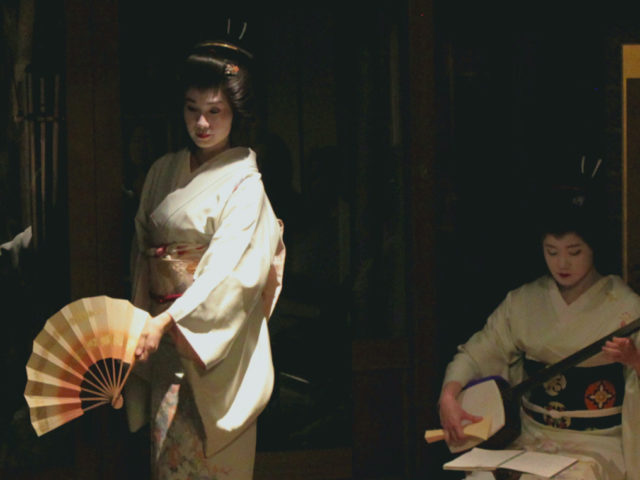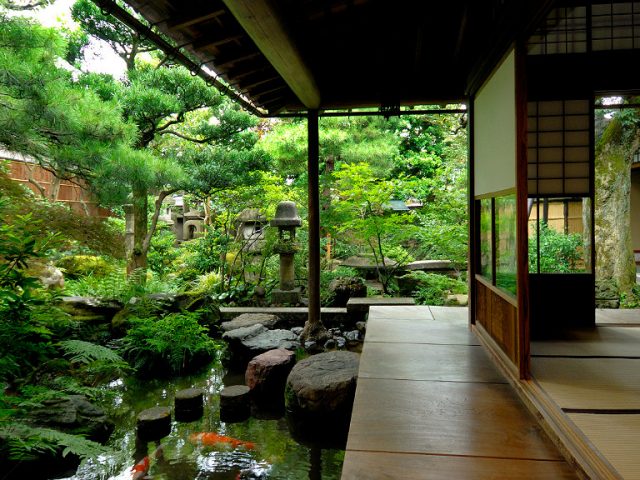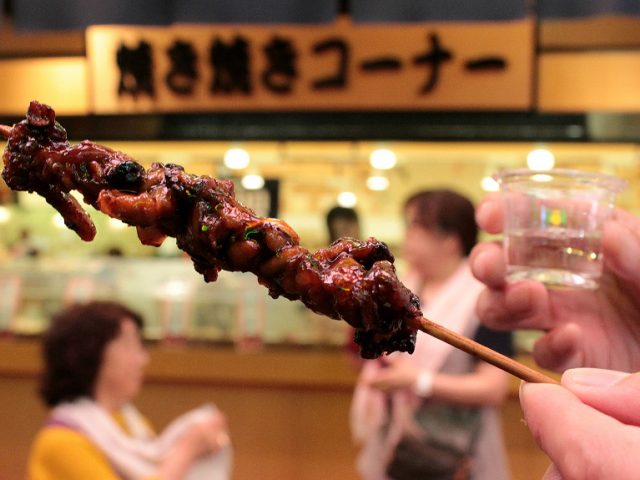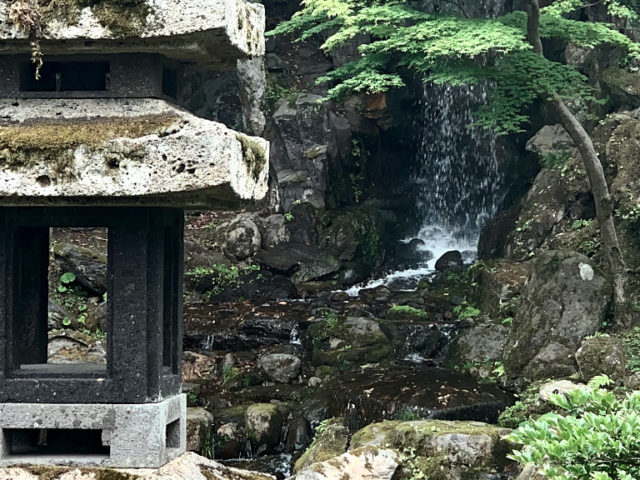The 3 Geisha Districts of Kanazawa
Many a tourist asks “Which way to the geisha district?” To which I reply, “But which one? Kanazawa has three!”
1. Nishi Chaya Gai, the “West” tea district
2. Kazue-machi: the hidden tea district
3. Higashi Chaya Gai: the “East” tea district, and the largest by far
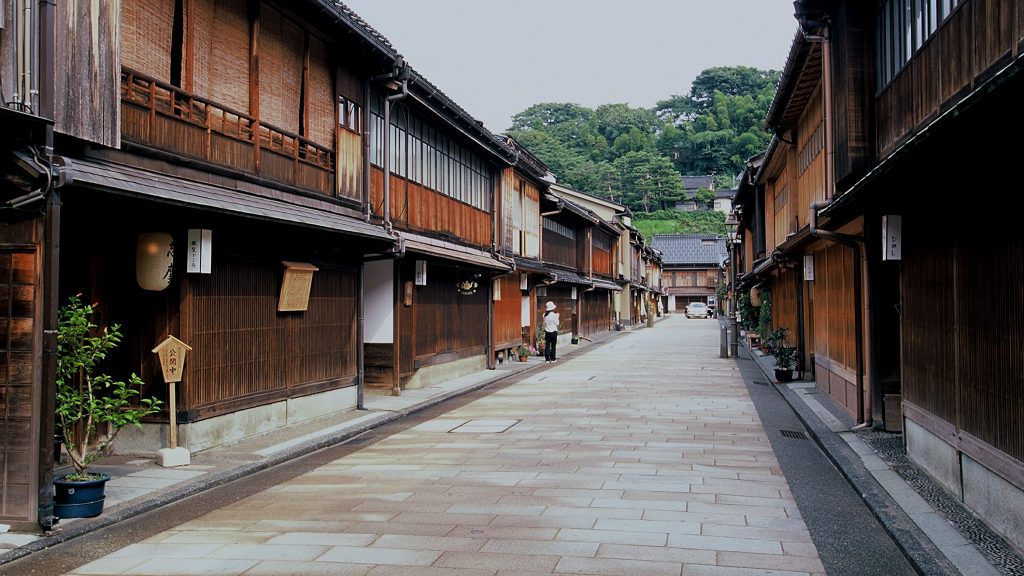 courtesy the City of Kanazawa
courtesy the City of Kanazawa
Of course, they most likely mean the most famous, Higashi Chaya. But the significantly smaller, yet equally charming Nisha Chaya and Kazue-machi districts are hidden gems of the castle town that few know.
Along these streets are many still-active tea houses open only in the evening and only to select clientele. But occasionally, the lucky visitor can spot a geisha walking to and from their work.
(Thank you for not disturbing them. Instead, see if you can catch one of their venues open to the public!)
So, what can you expect as you visit all three?
Nishi Chaya Gai, the geisha district to the west

Kanazawa survived the Second World War without a scratch. This means the city has retained the layout of the roads and the Edo period architecture that defined the look of feudal Japan. Kanazawa’s mysterious tea districts rank among the nation’s most photographed for just that reason.
Do you want to enjoy such settings yet avoid the more tourist-crowded areas? Nishi Chaya Gai is the recommended destination. Though only a single road, this geisha district has maintained its charm.
“West Geisha District”
During the day, sweet nut and bean shops, a casual cafe, and a wine bar occupy the street. The staff of each are open and friendly, and the top of the sweet shops offer a place to sit with a treat and a view of the street. The first of these greets you right as you enter the district!
Rakugan, the Kaga Region’s Dry Sweet of Choice

The first shop in the street proper is a dried sweets shop, Moroe-ya Rakugan.
Rakugan comes molded into seasonal shapes and is perfect with hot tea or coffee. Unlike wasanbon, the similarly molded sugar cakes of central Japan, rakugan incorporates rice flour, making the latter a softer, smoother, melt-in-your-mouth treat. Beloved for their long shelf-life in the winter months, rakugan make beautiful and delicious omiyage, “food souvenirs.”
Visitors can enjoy a sampling of rakugan or the more familiar soft sweet, wagashi, with matcha tea in a cafe in the back of the shop, overlooking a small garden. You can even cook your own mochi rice cakes should you opt for a sweet soup of sweet bean or white sesame.

The Ninja Weapons Museum
Next door is the unusual Ninja Weapons Museum. The bottom floor greets you with a gift shop, but head upstairs to see the private collection of samurai and ninja weapons and armor.
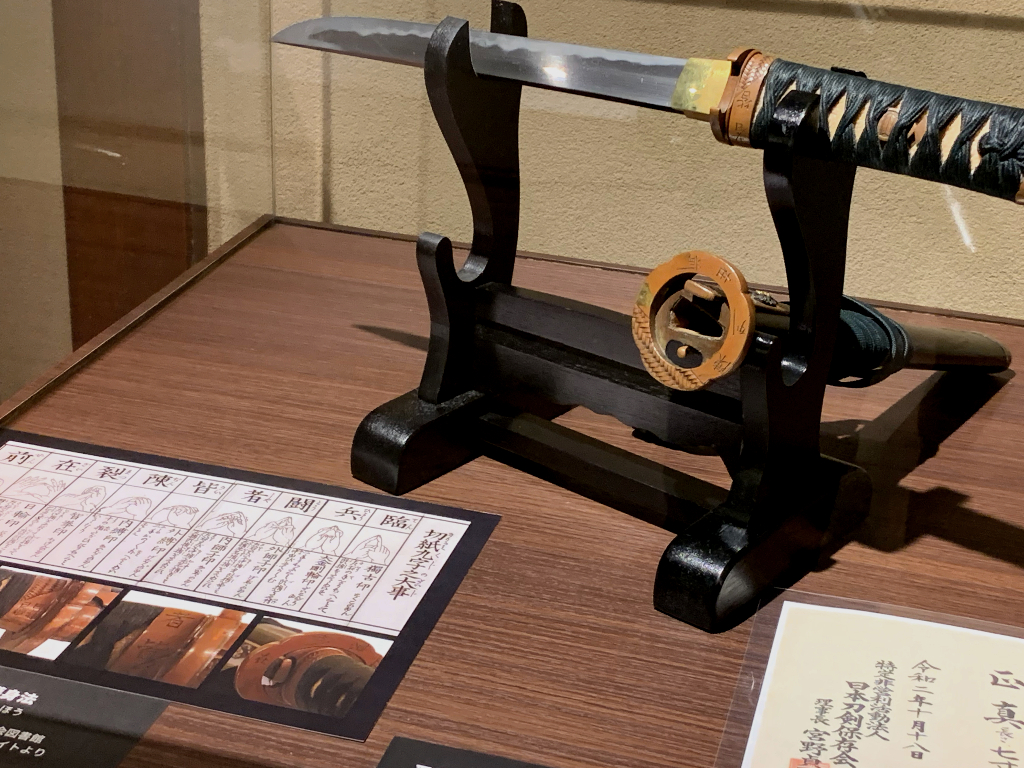 A prominently featured blade is adorned with the markings of the ninja’s hand signs, which center the mind and body in preparation for an attack.
A prominently featured blade is adorned with the markings of the ninja’s hand signs, which center the mind and body in preparation for an attack.
Though spanning only a few rooms, the items are plentiful, featuring everything from darts and shuriken stars to camouflaged swords and metal claws. Less well-known but clever gadgets include a gyroscopically balanced candle whose light can be hidden without being snuffed out and percussive bamboo strips meant to belie the number of guns firing at once.
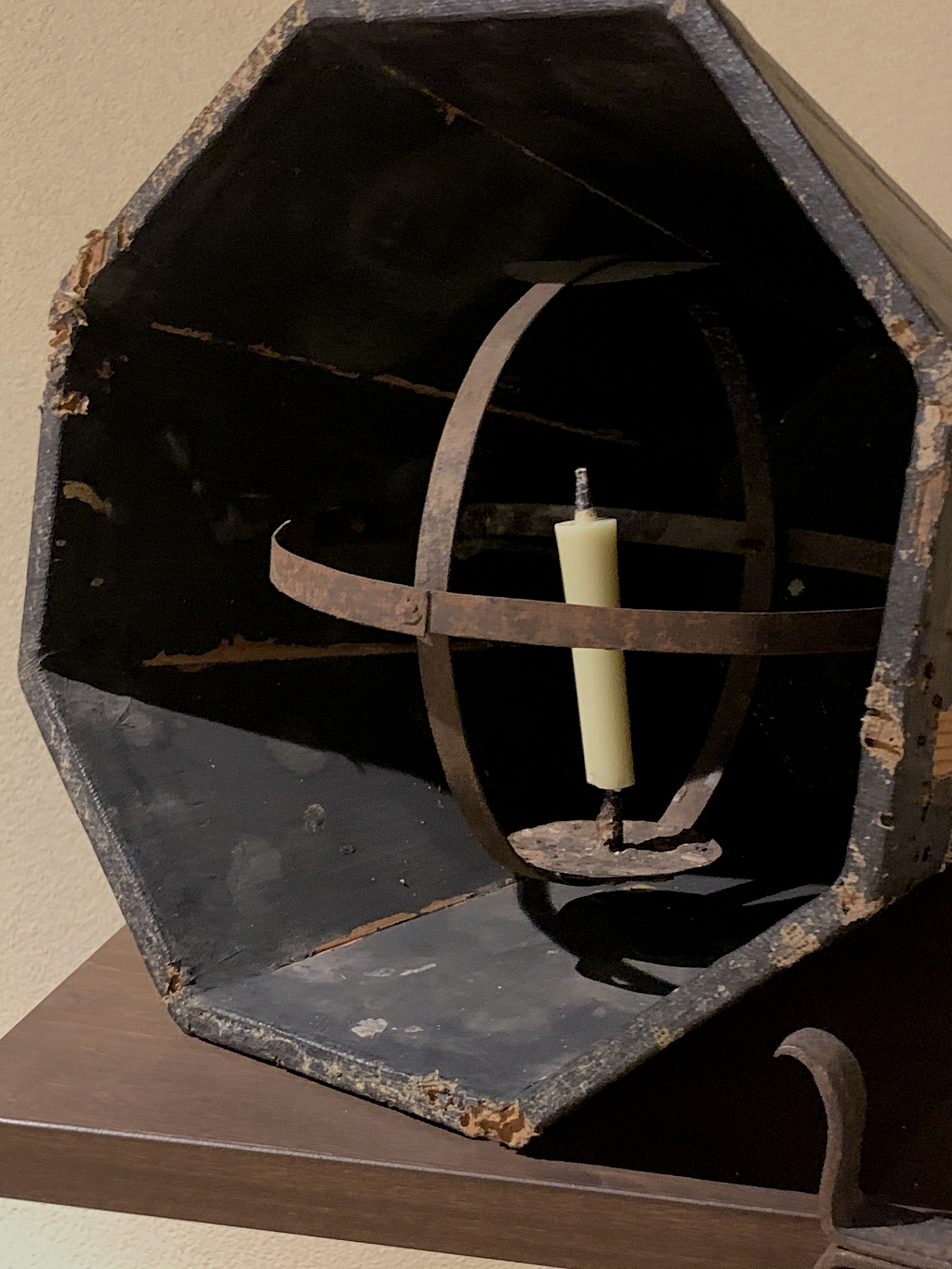
As the museum features both, this is a perfect between spot when transitioning from the Ninja Temple in the Teramachi district to the west and the Samurai District to the north.
The Dolls Museum
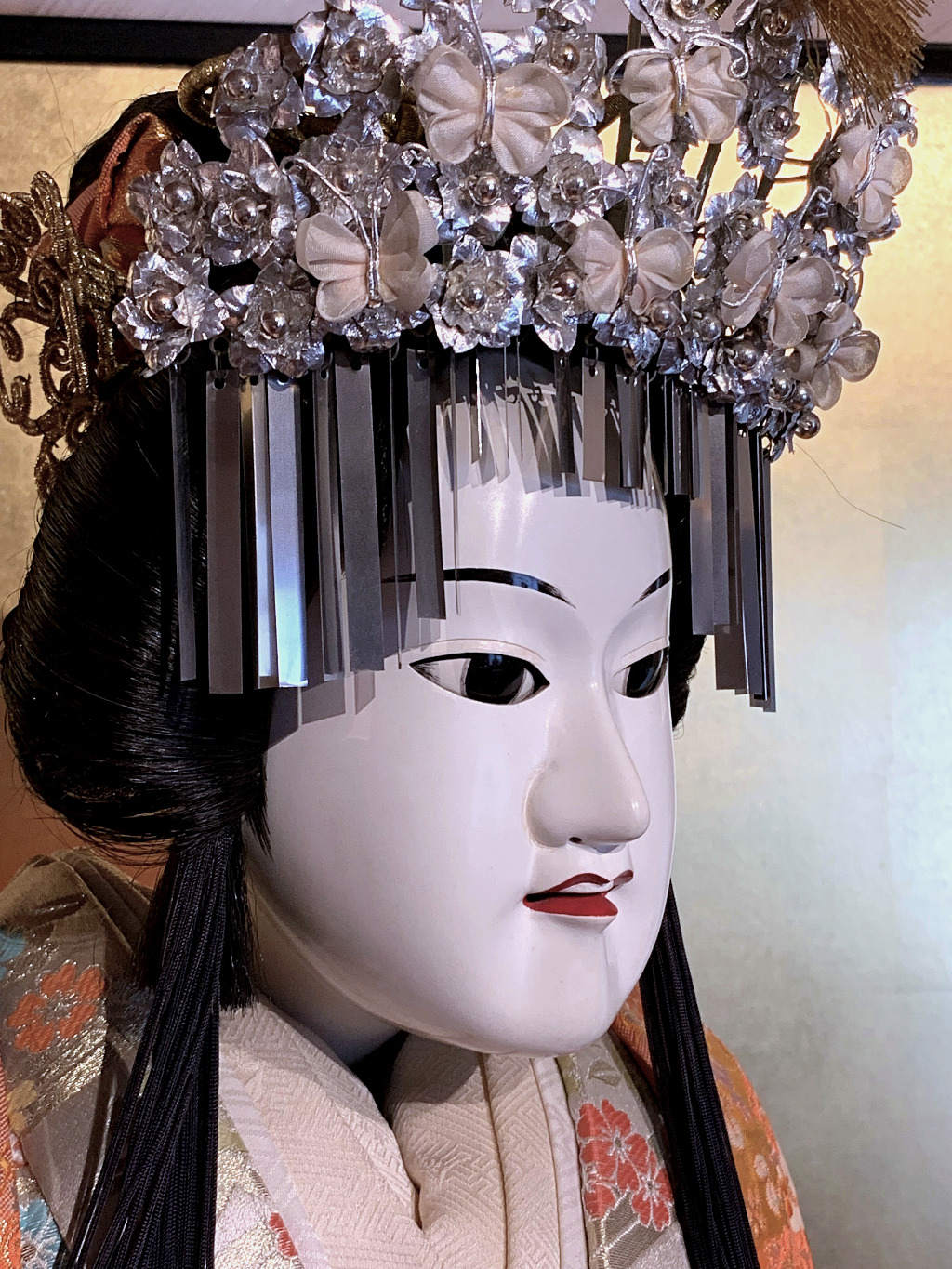
One of the district’s newest additions is the Dolls Museum [sic], a geisha tea house turned museum for an extensive collection of Japanese dolls. The various rooms feature dolls of all types and ages. In one room, a large table shaped like Japan’s three largest islands exhibits doll types by region.
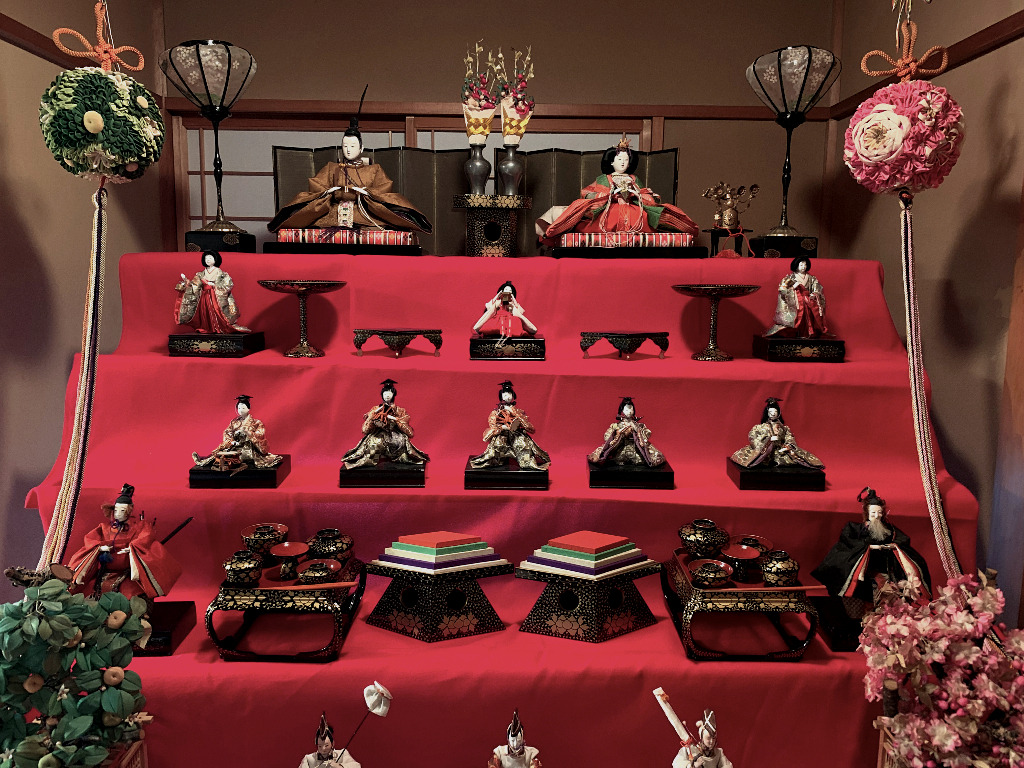
A Hina Matsuri display is usually seen in March for “Girl’s Day,” but at the Dolls Museum, this one stands indefinitely.
The museum is pricey at 800 yen per person, but the size of the collection, not to mention the beautiful tea house itself, makes the ticket worthwhile. True doll lovers should pop in here as well as Teahouse Nikorei in the Samurai District.
A Geisha’s Museum and Music
At the street’s opposite end is a free museum, the Nishi Chaya Shiryokan Museum, easily spotted by the lion dance masks in the front window.
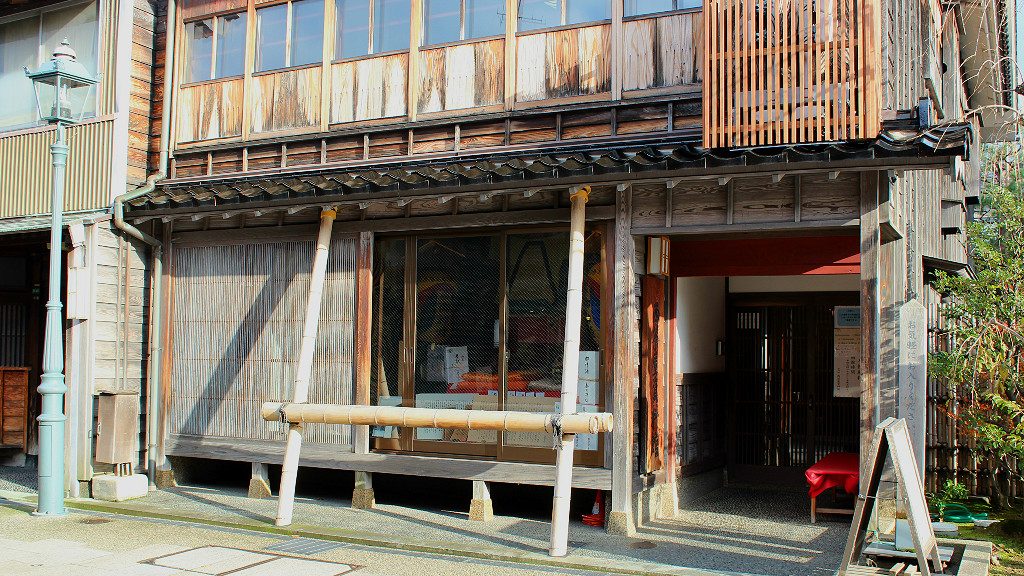
Its second floor showcases the specially decorated rooms geisha use to entertain guests: a bright, bengala-red dance room with an assortment of geisha instruments, and a traditional, intimately-small tea room. The dance hall is additionally unusual for its luxurious red lacquer wood finishes.
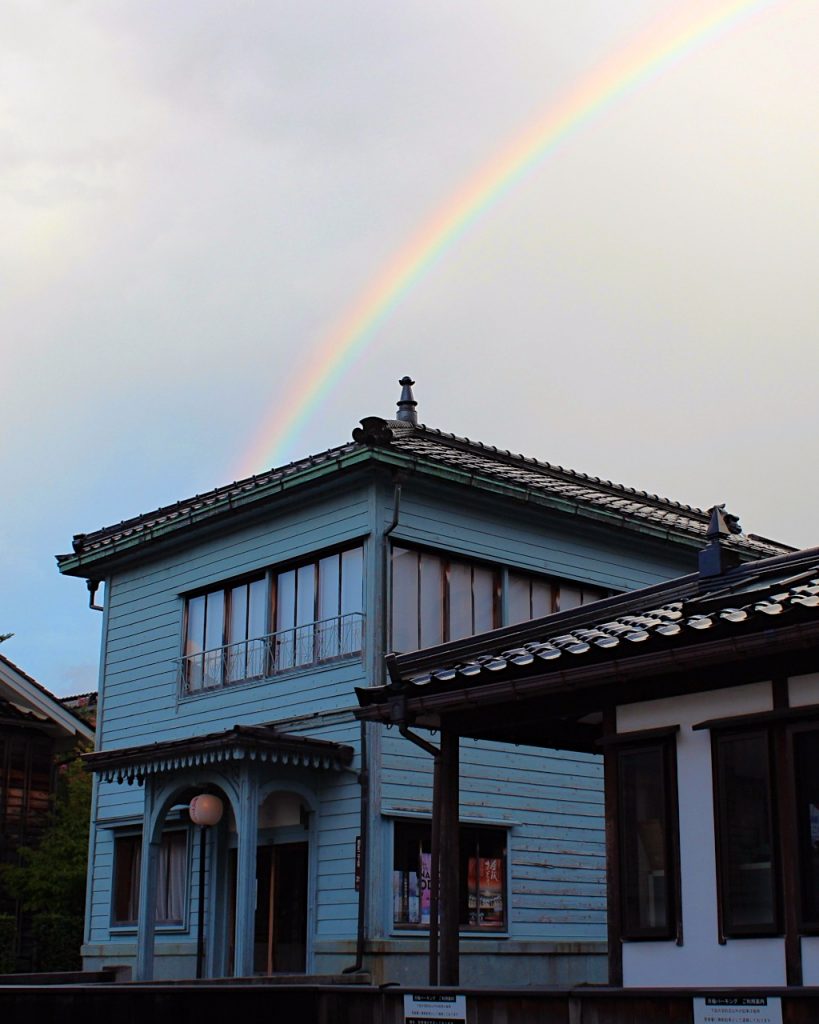
The powder blue European-style building next door is a geisha training hall, housing a music school for geisha. The sounds of taiko drums and shamisen strings often spill out onto the street.
Nishi Chaya Gai makes for a relaxing stopping point before or after the nearby Ninja Temple (250 m) or painting ceramics at the Kutani Kosen Kiln (350 m) just a few blocks away, or roaming the Samurai Residence District of Nagamachi (1 km).
Nishi Chaya Gai is 900 meters away from Kaname Inn Tatemachi and 150 meters from the nearest bus stop (広小路, Hirokoji).
Kazue-machi, the hidden geisha district

The most secretive of Kanazawa’s three geisha districts in both its design and feeling of discretion is Kazue-machi, named for Todakazue, a samurai family of the Kaga region.
Though it is larger than Nishi Chaya, it is also relatively small, made of only about twenty households packed tightly between bars and restaurants, in a small labyrinth of alleyways. With a walk along the cobbled riverside street, it’s no surprise that this district was the setting for forbidden romance in the 1978 novel Asanogawa Boshoku (“Asano River Dusk”) by Hiroyuki Itsuki.

Fewer shops are available to the public here, though the atmosphere and architecture alone are worth a stroll. Along the riverside is Sushi Asanogawa, a fine dining sushi restaurant open to non-Japanese guests and with a lovely view of the river. Or make group reservations early at Mifuku, a unique hotpot experience only available from November to March each year.
Hidden Stairs of Darkness and Light
With its rocky hills and proximity to the mountains, Kanazawa is known among the Japanese for its characteristic slopes and stairways that pepper the city. Two of the most notable are directly connected to the Kazue-machi geisha district: Akari-zaka, the “Lighted Slope,” and Kuragari-zaka, the “Dark Slope.”
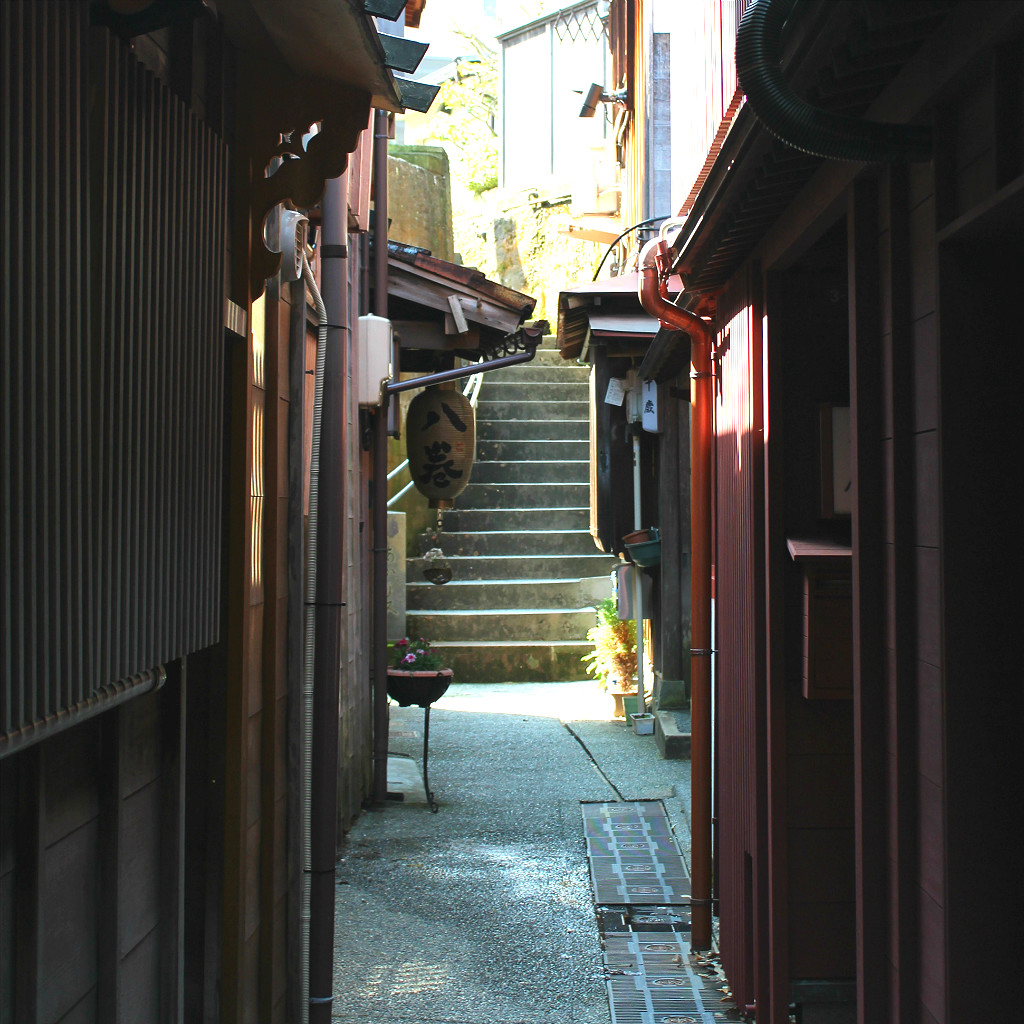
Toward the east side, Akari-zaka is the easiest to find, and bathed in sunlight on a clear day. It’s closest to the Hashibacho bus stop, and descending it feels like slipping into something mysterious and quiet, a neighborhood that sleeps even during the most bustling, sunny days.

Hidden around the back side of Kubo-ichi Otsutsurugi-gu Shrine is Kuragari-zaka.
The stairs are blocked on all sides, receiving sun only around noon of the clearest days. Yet at the bottom grows a lone sakura tree in front of the geisha’s practice center. Just to the side, you’ll find a door of wooden rabbit silhouettes. This is the private gallery and shop of a late modern woodblock artist who depicted Kanazawa and Kyoto in striking, vivid colors.
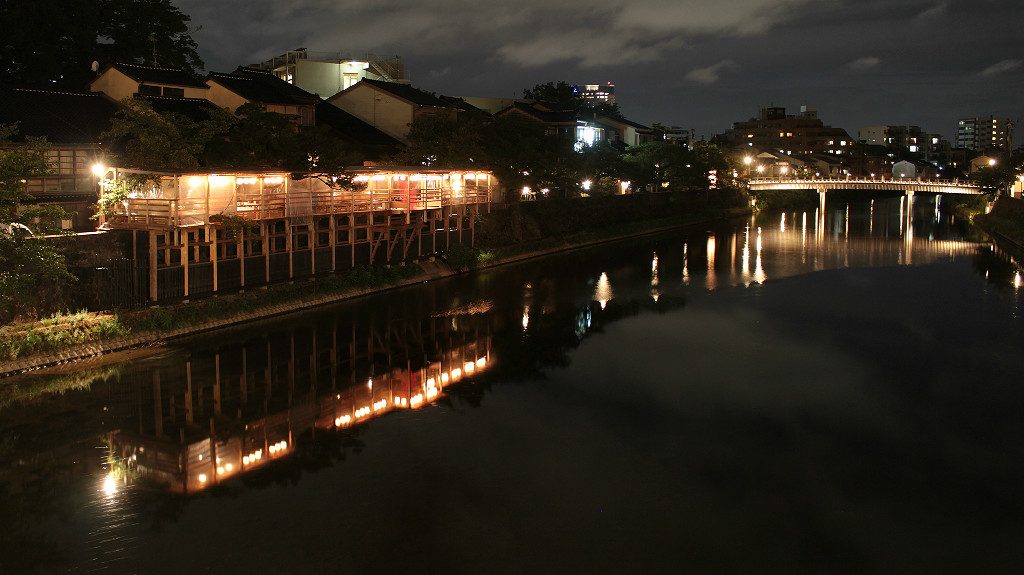 Kazue-machi expands its riverwalk during the Obon festival in August.
Kazue-machi expands its riverwalk during the Obon festival in August.
Kazue-machi is a photogenic spot between Kanazawa Castle and Higashi Chaya. It’s close to the residence of Kurando Terashima, the banished samurai (400 m), and the Morihachi Confectionery Molds Museum. It’s also directly diagonal to Higashi Chaya (200 m).
Kazue-machi is just over 2 kilometers away from Kaname Inn Tatemachi and a few feet away from the Hashibacho bus stop.
Higashi Chaya Gai, the largest geisha district, to the east
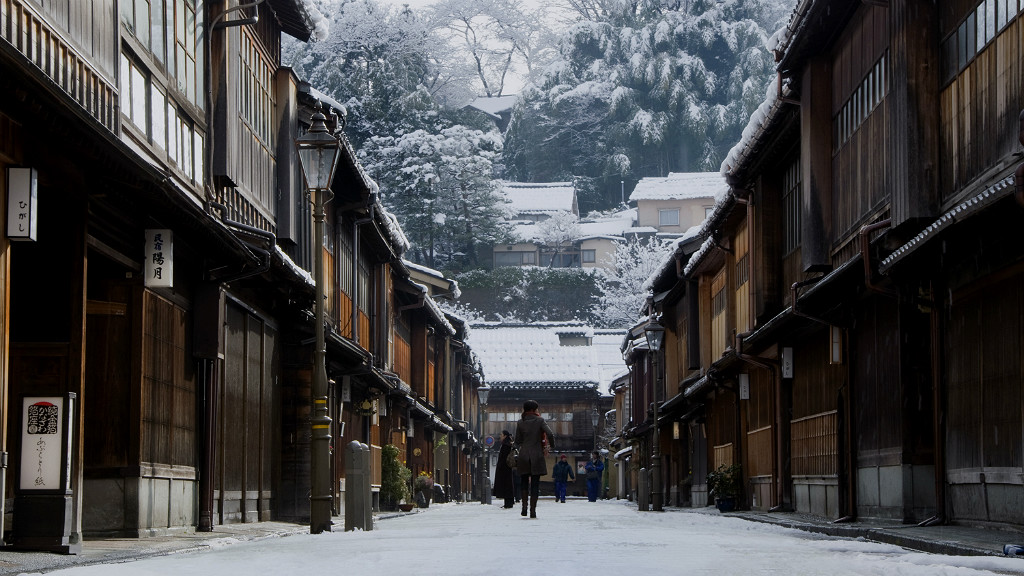 courtesy the City of Kanazawa
courtesy the City of Kanazawa
This is what you came for.
The geisha district of Higashi Chaya consists of a main street of the most famous tea houses in Kanazawa, surrounded by several neighborhoods of craftsmen, artists, and cafes. Often called Kanazawa’s “Old Town,” the stately wooden townhouses and cobbled streets are designed with for the pleasure of the merchant classes and the descendants of samurai. (Contrast with Takayama’s “Old Town,” built by and for the peasantry.)

“East Geisha District”
Higashi Chaya and Nishi Chaya opened together as east and west entertainment districts in the early Meiji Era under the local government. Originally, activity and movement were tightly regulated, with the districts sealed off from the rest of the city.
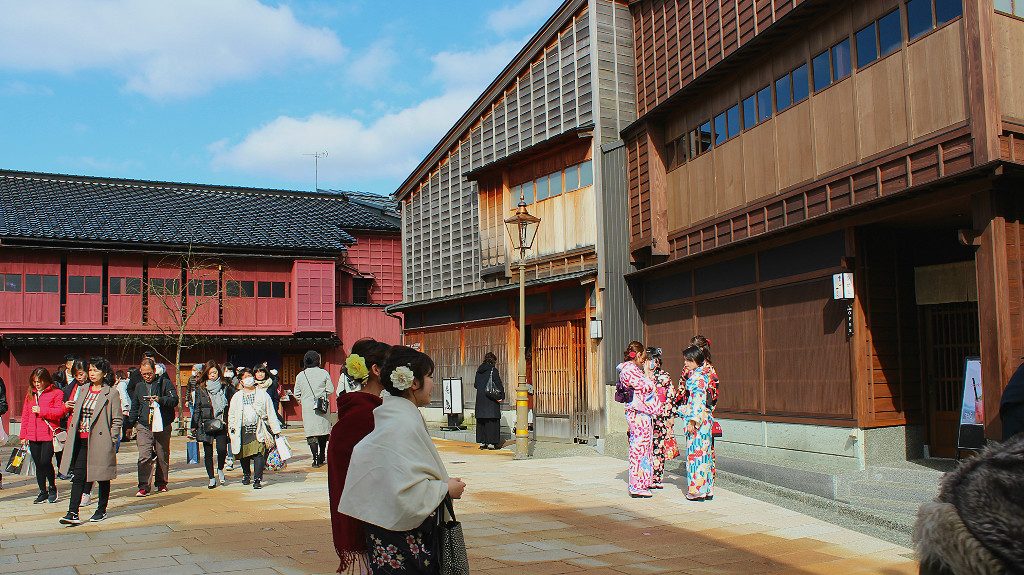
About two-thirds of the 140 buildings that make Higashi Chaya are protected. The most prominent are Kaikaro and Shima tea houses. Kaikaro features a tea room floored with gold-woven tatami mats and seasonal geisha shows in English. Both provide tours of pristine geisha entertainment houses, as well as matcha tea and sweets service.

It’s easy to spend a whole day in this one neighborhood
Higashi Chaya has a plethora of cafes and small restaurants, and signs with English are plentiful. I highly recommend Soba Buemon, just a few steps into a small alleyway from the main square. For traditional grilled fish and a wonderful sampling of sake rice wine from all around Ishikawa, Sake Bar Makoto is great for lunch or dinner.
Ice cream lovers shouldn’t miss the shop Kanazawa Aisu along the main street, where they can try ice cream that does not melt, invented here in Kanazawa! A few steps west of Kanazawa Aisu is Ukeian, a cake store specializing in one of Japan’s favorites, castella. As should be no surprise, they also offer castella-flavored ice cream, which has a rich, custardy taste. Around the south side of Higashi Chaya is a small shop, Noukaya Cafe, which sells ice cream and other treats made of roasted sweet potato.
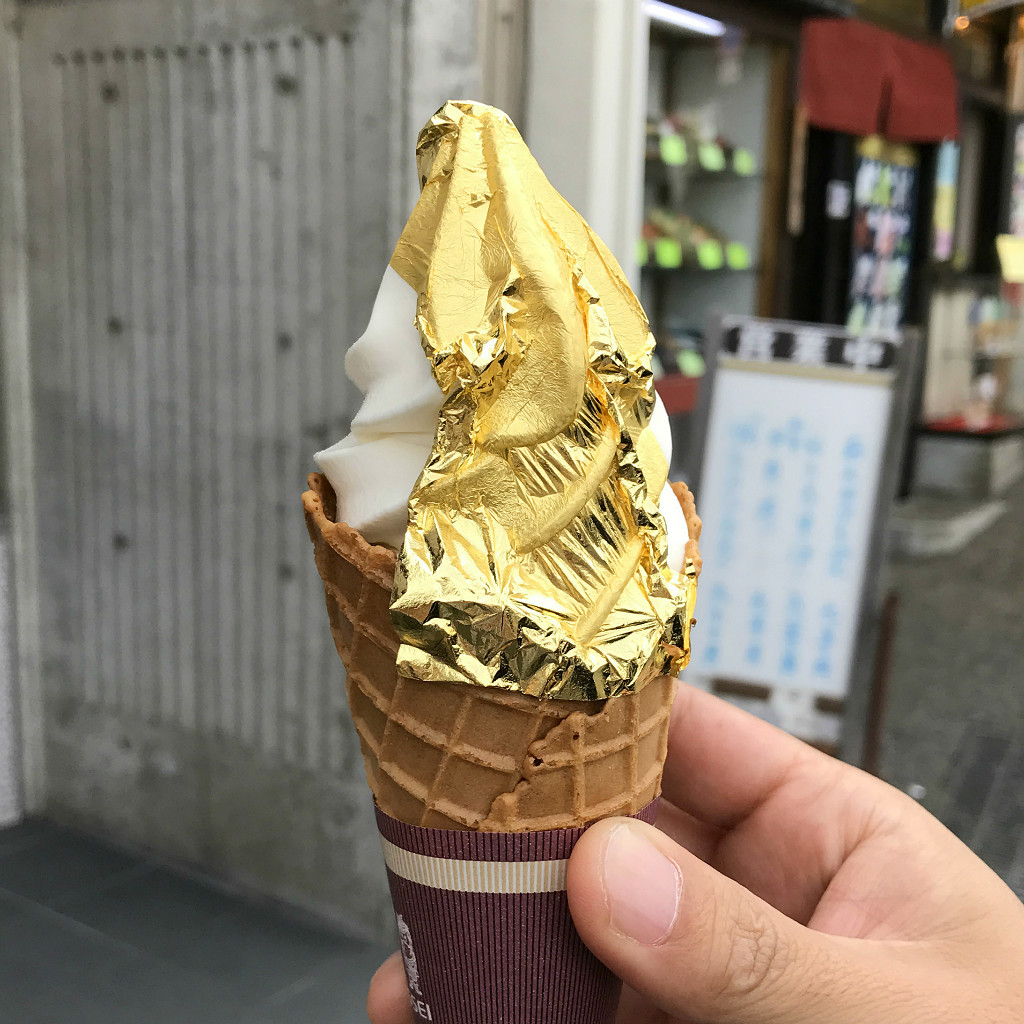
Of course, it being a feature tourist spot of Kanazawa, there is no shortage of gold leaf ice cream…
Higashi Chaya is also overflowing with shops featuring products made from gold leaf, one of Kanazawa’s chief crafts. Don’t neglect the alleyways away from the central street! A lot of these have small handmade craft shops and galleries, perfect for finding unique and interesting souvenirs.

This massive statue in the central Higashi Chaya branch of Gold Leaf Sakuda catches one’s eye even from the street!
More to see around the corner…
Head east, favoring rising roads to the north, and you’ll end up at the foot of Utasu Shrine. This is the historic former home of the spirit of Toshiie Maeda, Kanazawa’s first Edo-era lord. (He has since been moved to the more centrally located Oyama Shrine.) The shrine hosts bean-tossing geisha during the Setsubun holiday. And it’s also lush with sakura in spring!

For an extra treat, hike up the road a bit. Half-way up on the right, you’ll see steps leading to Hosen-ji Temple. A line of Buddha and Buddhist statues lead the way up, each with a unique pose and surroundings.

Kanazawa in one view
At the top, next to the temple and a shrine, is one of the loveliest views of Kanazawa. The tiled rooftops of the geisha district are visible below. Look far to the left for the castle can be seen far in the distance. And to the right, you’ll see the mountains that protect Ishikawa. It’s not unusual to look down on soaring black kites from this spot!

Higashi Chaya Gai is very close to the Kanazawa Yasue Gold Leaf Museum (100 m) and the Utasu Shrine (200 m). It’s also a short walk from Dining Bar Huni (550 m) further up the Asano River.
Higashi Chaya Gai is just over 2 kilometers away from Kaname Inn Tatemachi and a 200 meters from the nearest bus stop (橋場町, Hashibacho).

About a decade ago Rachel fell off a bus and then fell in love with this traditional-crafts and ice-cream-consuming capital of Japan. Editor and amateur photographer with a penchant for nature and history. Not actually fifty songbirds in a trench coat. (Former penname: Ryann)

